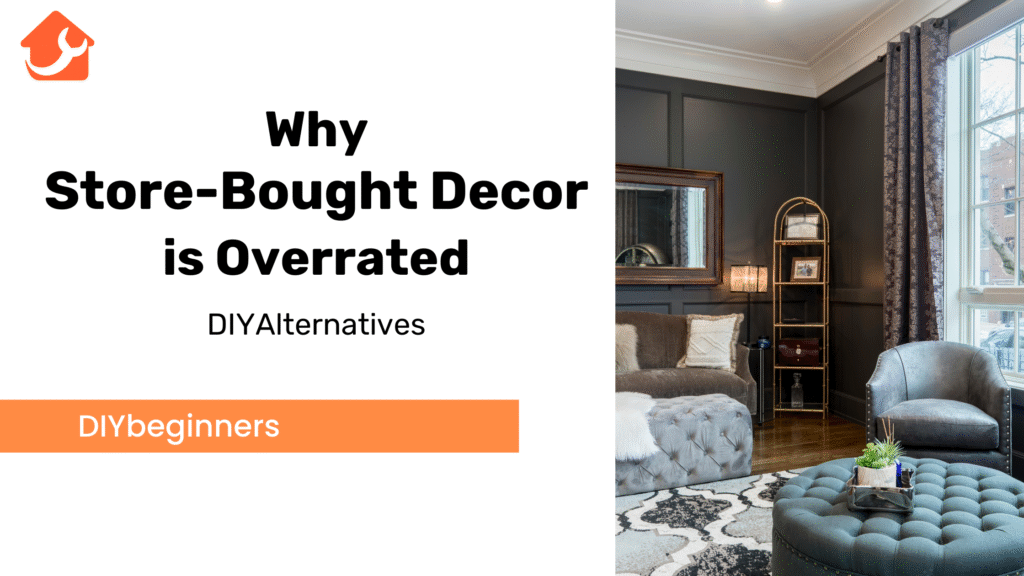
Tired of all of those rounded box frames and all of these ordinary-looking decorations in our homes that everybody has and are very expensive? For the small area of the budget-minded homeowner or apartment renter who would like to add some personality to their home, DIY decor is an artistic outlet that you simply cannot recreate in a store-bought piece. In this guide, we will talk about some of the downsides of retail decor, hidden costs, how you can take inexpensive items and turn them into statement pieces, and what simple do-it-yourself projects would be ideal to start with. You will also learn to save money and even more to create dramatic decoration that will tell your history.
The Hidden Costs of Store-Bought Decor
1. Financial Impact: How Retail Markups Drain Your Wallet
The lovely lamp you are seeing at Pottery Barn? It will be tagged up 400 percent above its production
cost. The markups of most of the mass-produced decorative items would make your jaw drop.
Imagine you are not only paying for the item. You are absorbing the rent of the store, the salary of the staff.
Staged advertisement campaigns and corporate profits. A possible one would be a simple 150 embellished bowl that would have been $30. Make. No, about a designer piece, I do not want to hear a word. Its price tags are usually based on the name that has been attached rather than on the quality itself or craftsmanship.
In the interim, homemade alternatives can save you a bundle of cash. The production of a handmade macram wall hanging at home would amount to 15 dollars as opposed to the purchased wall hanging dangling which costs about 90 dollars. That wooden shelf? About 25 dollars lumber vs. 200 bucks retail.
2. Environmental Consequences of Mass-Produced Items
The carbon footprint of your cute Target find is anything but cute. Mass-produced decor typically
involves:
- Overseas manufacturing (hello, massive shipping emissions)
- Synthetic materials derived from petroleum
- Toxic chemicals and dyes
- Excessive packaging waste
- Short lifespans leading to landfill bloat
3. Quality Concerns: When Expensive Doesn’t Mean Better
Have you ever purchased and carried home a decoration that is so unbelievably expensive to later find out it is nothing more than basically a decorated piece of cardboard? There is very little relationship between quality and retail prices any longer.
- Veneer over particle board passed off as “wood”
- Machine-made details marketed as “artisanal”
- Thin metal plating that chips within months
- Fabrics that fade after minimal sun exposure
- Glued components instead of proper joinery
4. The Emotional Cost of Owning Generic Pieces
Arriving at a friend’s house and seeing the same wall art decor on all the walls that you have in your house? You are not imagining that deflation. The standardised space is impersonal and is a result of standardised decor. There is a little voice given by purchased objects. They are not able to remember and exhibit your character. They tell it, I got hold of this from a catalog.
- The nagging emptiness of owning things without meaning
- Constantly chasing trends rather than developing your authentic style
- The subtle stress of living in a space that doesn’t truly reflect you
- Missing the pride and satisfaction of creating something yourself
Simple DIY Projects for Beginners
1. One-Hour Wall Art Transformations
And here is a suggestion. There is no necessity to spend a hundred bucks on a plain canvas print. You may create jaw-dropping wall art. You can do it within half the time of an episode of your favorite show. Apply some painter’s tape and give this plain canvas something geometrical. Just use a few of your colors and ones that matched your room, peel that tape off, and bam–custom art you would pay a lot of money to have.
Or this: put strips of cloth in frames of nice quality wrapping paper. Seriously. Seek beautiful material or papers, po,,p put them into the frames you find in the thrift store, and on the pennies you have, something gallery worthy. Not my favorite personally? Design washi tape and decorate the wall with your tape. No responsibility, but how much control and can even be able to change it any time you like.
2. No-Sew Textile Updates for Any Room
Your new best friend is going to be scissors and fabric glue. Those drab throw pillows? Rebase them by covering them with new fabric wrapped around them and fixed with fabric glue. No attaching machine is needed. Driven mad by plain curtains? Put on pom-pom trim or iron-on tape in loud colors along the sides. It is fifteen minutes long, but it looks completely made-to-order. And don’t forget drop cloths. They are inexpensive, tough as nails, and look just right in linen. Trim one to fit, turn up the edges, tape it in place with some fabric tape, and you have a table runner to rival anything in those posh home shops.
3. Upcycled Container Gardens That Impress
These second-hand teacups, glass jars, and empty tin cans? Don%erightarrow meas. Quit sending them off. They are Rosie-corners.
Clean out the Tin Can, Hammer in a bunch of Drain holes, give it one heavy coat of spray paint, and shazam. Succulentplanter. Put some of it into a group, and it will do wonders.
To upgrade an amazing kitchen herb garden, wooden crates can be used. Plastic-lined fill dirt and vegetation, and then you find you have decorations and supplies of food on top.
Tea Nu plus Chips? Not worth any more than wee plants. The weirder the cup, the better when they have a bit of touch of green on them, friends bust out.
Building a DIY Decor Community
1. Finding Inspiration Beyond Pinterest
Pinsanity does not come out of the blue. We’ve all found ourselves at that spot when we never stop scrolling through the staged photos, in a wonderment as to what we are doing wrong with our DIY.
Escape algorithmic trap! The undertakings that are made to look realistic often have their elaborate guides, which may be disregarded in the pretty images that are shared by Pinnacle. Follow artists on Instagram who are real and do not mind sharing their process, and not just nice result photographs.
And truth be told, you should give the screen some rest in between.. Go to second-hand stores, flea markets, or take a walk in nature to spark the sparks that no algorithm would ever predict. When visiting a beach, I got some driftwood and made the most likely piece of a wall decoration in my living room.
2. Sharing Skills Through Local Workshops
Anyone does not need a Master’s degree to make a person learn something new. For like, redoss.
Furniture? Knowing how to make dead killer concrete planters? Share it!
Workshop hosts are frequently invited to many places, such as community centers, libraries, coffee shops, and local hangouts. Start at 5- 6 members/charge to members what is required to cover materials, with a little extra to compensate your time.
The teaching makes you dissect your work, and this enhances your performance. Plus, nothing
trumps the self-esteem boost of seeing someone make something beautiful via methods you lawfully Jacob owes you some money. Taught them.
3. Trading Handmade Items to Diversify Your Collection
The best budget decorators keep their best tricks to themselves.. DIY swapsThat’sthehat macram wall hang you have made 3 times? Exchange it with an artist who produces the type of ceramic vases that you have always envied to make. Have a quarterly swap meet of your crafty friends. There are simple rules, and they are as follows: bring something that you have created and leave with something new.
Hand-painted throw pillows are in my living room, a lovely wood serving tray, and a pair of printed leaves–not one of which I ever produced, but all made by friends and now worn on my home-made article.
Do things at home. The kicker? Every object has a narrative and an affiliation that a store-bought decor can not compare with.
Conclusion
The trick of frugal home decorators is DIY swaps. Thrice in throwing o’er the macram wall Thou hast winning o’erone This home of thine, this dressing o lo’erne This big chucchunk which we call thy wall
times? Exchange it with another who will make you ceramic vases you have always dreamed of trying. Toss in a quarterly trade-up once now and again with your crafty friends. The only rules are bring what you make and get something new. My living room has hand-painted throw pillows, a beautiful wood serving tray, and a series of botanical prints all made by friends–and instead of stuffing my house with my handmade items, my friends now hang those things on their walls.
And what is the worst of it? Its pieces each bring a story and a relationship that store-bought decor just cannot compete Decorating with handcrafted items and making your home decor has innumerable advantages over bought store-bought decor. Not only will the DIY projects end up saving you money over time, but you will also have full creative control over your living space. Whether it is simple starter projects or crafting things found in everyday objects, you can do anything you like when you open your imagination. Start the process of turning your home into a more personalized environment and experiment with one of the above projects that are novice-friendly. You should also think of coming or creating a community of DIY decor with which you can share ideas, teach each other new styles, and applaud each other in our creations. Home is the place where your own story should be observed–and nobody can tell it better than you.
